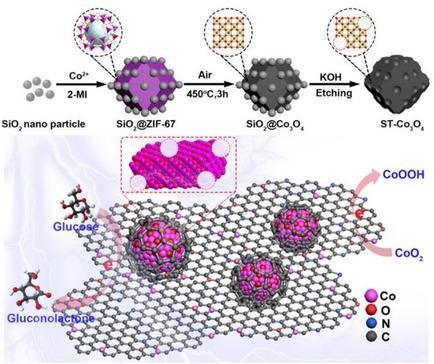当前位置:
X-MOL 学术
›
ChemElectroChem
›
论文详情
Our official English website, www.x-mol.net, welcomes your
feedback! (Note: you will need to create a separate account there.)
Silica‐Templated Metal Organic Framework‐Derived Hierarchically Porous Cobalt Oxide in Nitrogen‐Doped Carbon Nanomaterials for Electrochemical Glucose Sensing
ChemElectroChem ( IF 3.5 ) Pub Date : 2021-01-20 , DOI: 10.1002/celc.202001588 Qiuhong Sun 1 , Junyang Ding 1 , Dandan Chen 1 , Cheng Han 1 , Minghua Jiang 2 , Ting-Ting Li 3 , Yue Hu 1 , Jinjie Qian 4 , Shaoming Huang 5
ChemElectroChem ( IF 3.5 ) Pub Date : 2021-01-20 , DOI: 10.1002/celc.202001588 Qiuhong Sun 1 , Junyang Ding 1 , Dandan Chen 1 , Cheng Han 1 , Minghua Jiang 2 , Ting-Ting Li 3 , Yue Hu 1 , Jinjie Qian 4 , Shaoming Huang 5
Affiliation

|
As glucose molecules are well recognized to supplement the main energy source of living cells as the intermediate product of metabolism in human body, it is of great importance to develop a convenient and quantitative glucose sensor with high selectivity, high sensitivity, and high accuracy. In this work, a simple and novel strategy has been developed to obtain a high‐performance non‐enzymatic glucose sensor by constructing hierarchically porous Co3O4 embedded into the metal organic framework (MOF)‐derived N‐doped carbon matrix based on a SiO2 template, denoted as ST‐Co3O4. The removal of the SiO2 template creates abundant voids and a large specific surface for the obtained layered mesoporous ST‐Co3O4 composite, which enhances the electron transfer kinetics and the ability to adsorb biomolecules, further greatly improving the surface reaction efficiency and promoting the improvement of its catalytic performance. Compared with pure Co3O4 nanoparticles from ZIF‐67 without a silica template, as‐obtained ST‐Co3O4 shows a good mesoporous environment, provides more active sites, and makes the non‐enzymatic glucose sensor exhibit high sensitivity (2860 μA mM−1 cm−2) and fast response time (<1 s) over a wide linear glucose concentration range of 1.0–1300.0 μM. Additionally, the ST‐Co3O4/CC electrode demonstrates good anti‐interference, high repeatability, and robust stability (>3000 s), which can repeatedly detect the glucose species in real human serum (RSD<9.69 %, n=3), and shows broad prospects in non‐enzymatic sensors.
中文翻译:

二氧化硅模板金属有机骨架在氮掺杂碳纳米材料中衍生的用于氧化葡萄糖传感的分层多孔氧化钴。
由于人们公认葡萄糖分子可以补充作为人体新陈代谢的中间产物的活细胞的主要能源,因此开发一种具有高选择性,高灵敏度和高精度的便捷定量葡萄糖传感器具有重要意义。在这项工作中,已经开发出一种简单新颖的策略,通过构建嵌入到金属有机骨架(MOF)衍生的N掺杂碳基体中的分层多孔Co 3 O 4来获得高性能的非酶葡萄糖传感器。SiO 2模板,表示为ST-Co 3 O 4。SiO 2的去除模板为所得的层状中孔ST-Co 3 O 4复合材料创建了丰富的空隙和较大的比表面积,从而增强了电子转移动力学和吸附生物分子的能力,从而进一步大大提高了表面反应效率并促进了其催化性能的提高。与不含二氧化硅模板的ZIF-67纯Co 3 O 4纳米颗粒相比,所获得的ST-Co 3 O 4具有良好的介孔环境,提供了更多的活性位点,并使非酶葡萄糖传感器具有很高的灵敏度(2860)。 μA毫米-1 厘米-2)和在1.0–1300.0μM的宽线性葡萄糖浓度范围内的快速响应时间(<1 s)。此外,ST-Co 3 O 4 / CC电极显示出良好的抗干扰性,高重复性和强大的稳定性(> 3000 s),可以重复检测真实人血清中的葡萄糖种类(RSD <9.69%,n = 3) ),并在非酶传感器中显示出广阔的前景。
更新日期:2021-03-01
中文翻译:

二氧化硅模板金属有机骨架在氮掺杂碳纳米材料中衍生的用于氧化葡萄糖传感的分层多孔氧化钴。
由于人们公认葡萄糖分子可以补充作为人体新陈代谢的中间产物的活细胞的主要能源,因此开发一种具有高选择性,高灵敏度和高精度的便捷定量葡萄糖传感器具有重要意义。在这项工作中,已经开发出一种简单新颖的策略,通过构建嵌入到金属有机骨架(MOF)衍生的N掺杂碳基体中的分层多孔Co 3 O 4来获得高性能的非酶葡萄糖传感器。SiO 2模板,表示为ST-Co 3 O 4。SiO 2的去除模板为所得的层状中孔ST-Co 3 O 4复合材料创建了丰富的空隙和较大的比表面积,从而增强了电子转移动力学和吸附生物分子的能力,从而进一步大大提高了表面反应效率并促进了其催化性能的提高。与不含二氧化硅模板的ZIF-67纯Co 3 O 4纳米颗粒相比,所获得的ST-Co 3 O 4具有良好的介孔环境,提供了更多的活性位点,并使非酶葡萄糖传感器具有很高的灵敏度(2860)。 μA毫米-1 厘米-2)和在1.0–1300.0μM的宽线性葡萄糖浓度范围内的快速响应时间(<1 s)。此外,ST-Co 3 O 4 / CC电极显示出良好的抗干扰性,高重复性和强大的稳定性(> 3000 s),可以重复检测真实人血清中的葡萄糖种类(RSD <9.69%,n = 3) ),并在非酶传感器中显示出广阔的前景。

































 京公网安备 11010802027423号
京公网安备 11010802027423号